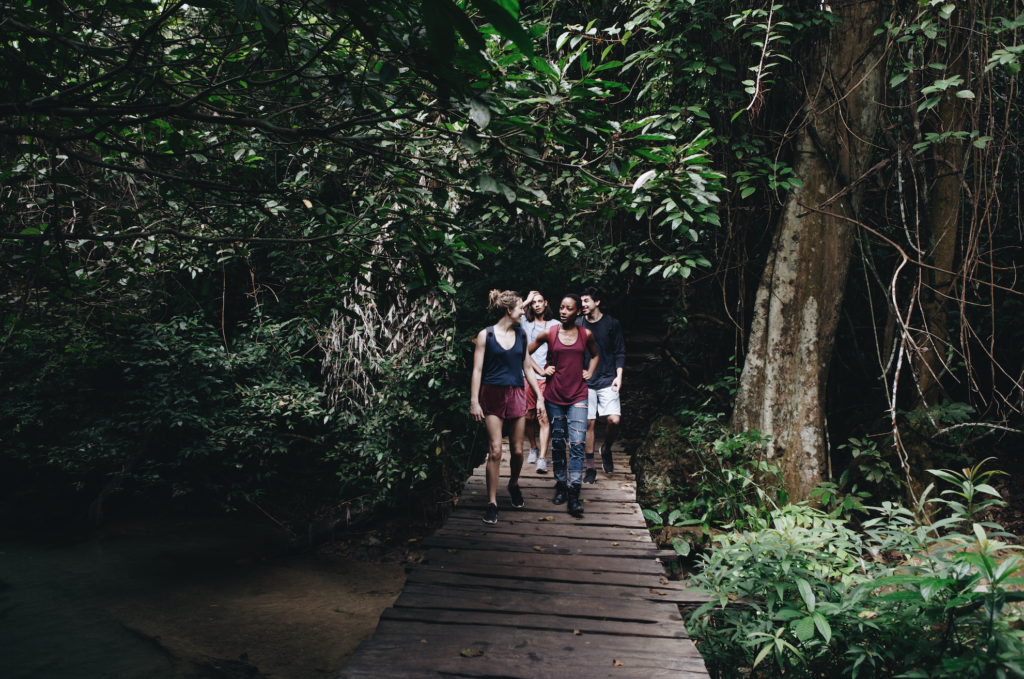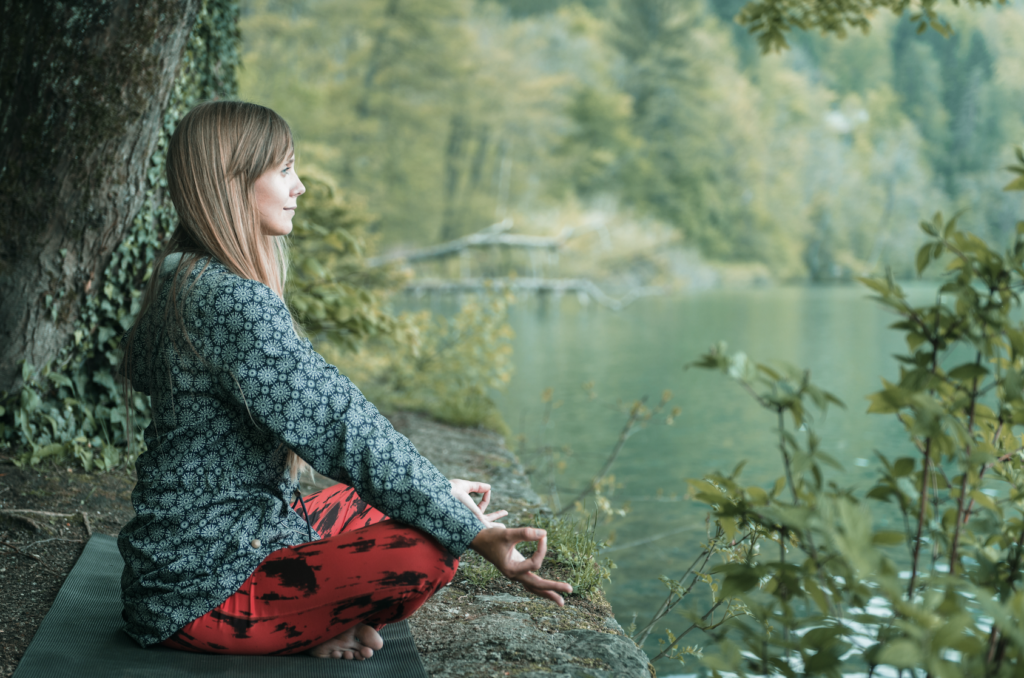
Forest Bathing หรือ การอาบป่า เป็นการรับรู้บรรยากาศของป่าผ่านประสาทสัมผัสของเรา โดยจะเชื่อมเรากับธรรมชาติและใช้ธรรมชาติในการช่วยบำบัดความเครียด ความอ่อนล้า ที่เกิดขึ้นจากการทำงาน หรือ จากการดำเนินชีวิตได้
ด้วยรูปแบบของการใช้ชีวิตในปัจจุบัน ยกตัวอย่างในกรุงเทพฯ สังคมเมืองทำให้เราเห็นแต่ตึกรามบ้านช่อง คอนโด ทาวน์โฮม ทาวเฮาส์ และตึกสำนักงานผุดขึ้นกันราวกับดอกเห็ด ในทางกลับกันพื้นที่สีเขียวกลับลดลงอย่างเห็นได้ชัดเจน ถึงแม้ว่าเราจะมีสวนสาธารณะขนาดใหญ่และขนาดย่อมหลายแห่ง แต่ก็ยังไม่สามารถทดแทนพื้นที่สีเขียว หรือ จำนวนต้นหมายที่ต้องหายไปได้เลย
ด้วยความเจริญทางสังคมและเศรษฐกิจ ทำให้ผู้คนเป็นจำนวนมากหลั่งไหลกันเข้ามาอยู่ในเมืองหลวง ต้องมาทำงานในอาคารสำนักงานที่สูงเสียดฟ้า ต้องใช้ชีวิตควบคู่ไปกับอุปกรณ์อิเล็กทรอนิกส์รวมไปถึงการหมดเวลามากมายไปกับการใช้ชีวิตในโลกออนไลน์ ทำให้พวกเขาทั้งตัวและจิตใจอยู่ห่างไกลจากธรรมชาติออกไปทุกที ผลที่ตามมาก็คือ การขาดสมดุลย์ของชีวิต
“มีผู้คนจำนวนมากใช้เวลาอยู่บน Social Media มากกว่าเวลานอนเสียอีก”
ดร. Qing Li นักวิจัยชาวญี่ปุ่น ได้นำเสนอสถิติจากงานวิจัยของเขาว่าภายในปี 2050 ตามรายงานของ United Nations Population Division จะมี 3 ใน 4 ของประชากรจะอาศัยอยู่ในเมืองแทนพื้นที่ชนบทหรือจังหวัดที่ห่างไกลความเจริญ แม้กระทั่งในขณะนี้ ตัวอย่างเช่น คนอเมริกันโดยเฉลี่ยแล้วพวกเขาใช้เวลาอยู่ในบ้านถึง 93 เปอร์เซ็นต์ และในขณะที่พวกเขาอยู่บ้าน พวกเขาจะใช้เวลาหมดไปกับ Social Media ประมาณ 10 ชั่วโมงต่อวัน ซึ่งข้อเท็จจริงนี้แสดงให้เห็นว่าเวลาของพวกเขาหมดไปกับเรื่องไม่มีประโยชน์ ซึ่งนั่นมันมากกว่าเวลาที่พวกเขานอนเสียอีก นั่นจึงเป็นที่มาของการค้นหาวิธีการที่จะทำให้มนุษย์กลับเข้าสู่ชีวิตที่สมดุลย์
จุดเริ่มต้นของการอาบป่า
ญี่ปุ่นเป็นประเทศที่พัฒนาแล้ว มีความเป็นเมืองและป่าทึบ มีจำนวนต้นไม้ครอบคลุมพื้นที่ถึง 2 ใน 3 ของพื้นที่ทั้งหมดของประเทศ แต่ญี่ปุ่นกลับกลายเป็นเมืองที่มีคนพลุกพล่านมากที่สุดในโลก เพราะคนญี่ปุ่นส่วนใหญ่เลือกที่จะยัดเยียดตัวเองเข้าไปอาศัยและทำงานอยู่ในเมือง เลือกที่จะใช้ชีวิตอยู่กันอย่างแออัดและเบียดเสียด พื้นที่สีเขียวในเมืองถูกลดทอนลงไป ทำให้ปัญหาในเรื่องสุขภาพจิตสูงขึ้น อาทิเช่น อาการเสียสมาธิ มีความเครียดสะสม มีภาวะซึมเศร้า รวมไปถึงอาการเจ็บปวดต่างๆ ที่เกิดขึ้นในร่างกาย รัฐบาลในตอนนี้เล็งเห็นว่าปัญหาเหล่านี้กำลังจะกลายเป็นปัญหาใหญ่ จึงมีการเปิดตัวโครงการระดับชาติที่เป็นโครงการสนับสนุนการอาบป่าขึ้น ในปี 2525

การอาบป่า (Forest Bathing) เป็นการบำบัดแบบญี่ปุ่น ไม่ใช่การเข้าป่า เพื่อไปออกกำลังกาย หรือ ไปเดินป่า ไปปีนเขา “การอาบป่า”ในที่นี้มีความหมายมาจากคำว่า ชินรินโยคุ (Shinrin-yoku) แยกออกเป็นคำว่า ชินริน (Shinrin) แปลว่า ป่า และ โยคุ (Yoku) แปลว่า อาบ จึงแปลรวมกันว่า “การอาบป่า” การอาบป่า จะเป็นวิธีการที่จะช่วยเชื่อมตัวเราเข้ากับธรรมชาติผ่านประสาทสัมผัสทั้ง 5 ผ่านรูป รส กลิ่น เสียง และสัมผัส โดยใช้ธรรมชาติบำบัดในการชำระล้างความเครียด ความวิตกกังวล ความอ่อนล้าที่แบกไว้ในวามคิดและจิตใจ ซึ่งถือเป็นวิธีการบำบัดตัวเองในแบบง่ายๆ ที่สามารถทำเองคนเดียวได้ในระยะเวลาอันสั้น หรือจะชักชวนกันทำเป็นกลุ่มแบบในครอบครัว หรือ ในที่ทำงานก็ได้เช่นกัน
“ในแต่ละปี ประเทศญี่ปุ่นจะมีคนมากกว่า 2.5 ล้านคน เดินไปตามเส้นทางในป่า เพื่อบรรเทาความเครียดและเพื่อเสริมสร้างสุขภาพ”
การอาบป่า เป็นการเดินช้าๆ ในป่า เพื่อให้เราได้ซึมซับบรรยากาศผ่านประสาทสัมผัสทั้งหมดของเรา หลังจากเกิดโครงการสนับสนุนการอาบป่าขึ้น ก็มีการศึกษาที่พบว่าป่าไม้และสุขภาพของมนุษย์มีจุดที่เชื่อมต่อกัน นักศึกษาแพทย์ที่มีความเครียด หลังจากที่พวกเขาได้ออกไปตั้งแคมป์ในป่า พวกเขาพบว่ามันช่วยฟื้นฟูสุขภาพร่างกายและอารมณ์ของพวกเขาได้ดี เรื่องการอาบป่า จึงกลายเป็นแรงบันดาลใจให้กับกลุ่มนักวิจัยในการค้นคว้าเกี่ยวกับประโยชน์ของป่าที่มีต่อสุขภาพและความเป็นอยู่ที่ดีขึ้นของมนุษย์
“ทุกที่ ที่มีต้นไม้ เราก็มีสุขภาพที่ดีขึ้นและมีความสุขมากขึ้น”
ประมาณ 20 ปีที่แล้ว นักชีววิทยาชาวอเมริกัน E. O. Wilson ตั้งข้อสังเกตเอาไว้ว่า มนุษย์มีสายใยที่เชื่อมโยงกันกับโลกของธรรมชาติ กล่าวคือ การอยู่ในธรรมชาติจะสร้างผลลัพธ์เชิงบวกต่อสุขภาพของมนุษย์ และหลังจากที่ Qing Li ศึกษาเรื่องนี้ต่อมาอีกหลายปี เขาพบว่าการใช้เวลาอยู่ในป่าสามารถลดความเครียด ความวิตกกังวล ความซึมเศร้า และความโกรธได้ นอกจากนี้ยังช่วยเสริมสร้างระบบภูมิคุ้มกันให้กับร่างกาย และยังช่วยทำให้สุขภาพหัวใจและหลอดเลือด รวมไปถึงระบบเผาผลาญในร่างกายดีขึ้นได้อีกด้วย ถือเป็นการเพิ่มความเป็นอยู่ที่ดีขึ้นโดยรวมให้กับมนุษย์ได้อีกด้วย

“เราจะนอนหลับได้ดีขึ้นเมื่อเราใช้เวลาอยู่ในป่า แม้ว่าเราจะไม่ได้ออกกำลังกายเพิ่มขึ้นเลยก็ตาม”
งานวิจัยชิ้นหนึ่งของ ดร. Qing Li พบว่าการอาบป่าสามารถช่วยเรื่องการนอนหลับในหมู่พนักงานออฟฟิศวัยกลางคนที่อาศัยอยู่ในโตเกียวได้ ซึ่งพวกเขามีปัญหาในเรื่องของการนอนหลับอันเนื่องมาจากระดับความเครียดทีมีสูงมากจากเรื่องงานหรือจากเรื่องของการเรียนหนังสือ โดยกลุ่มอาสาสมัครผู้เข้าร่วมการทดลองในครั้งนี้ ได้ออกเดินป่าโดยใช้เวลาเท่ากันกับเวลาทำงานปกติที่พวกเขาทำอยู่ในเมือง ผลลัพธ์ที่ได้คือพวกเขามีระดับความเครียดและความกังวลน้อยลงอย่างเห็นได้ชัดเจน พวกเขาสามารถนอนหลับได้ง่ายขึ้นและนานขึ้น นอกจากนี้ยังพบอีกว่าการเดินป่าในช่วงบ่ายจะมีประโยชน์มากกว่าในการเดินตอนเช้าอีกด้วย
“สิ่งที่เราต้องทำก็คือ ตอบรับคำเชิญจากธรรมชาติ ส่วนที่เหลือก็ปล่อยให้ธรรมชาติได้จัดการเอง”
การอาบป่า เป็นศาสตร์ที่ช่วยบำบัดโรคการขาดธรรมชาติที่สามารถทำได้ไม่ยากเลย วิธีการมันเรียบง่ายและนี่คือขั้นตอนที่เราต้องทำในการอาบป่า
- หาสถานที่: การหาแหล่งธรรมชาติที่ดีสักที่นึงขึ้นอยู่กับว่า เราอาศัยอยู่ที่ไหน เราไม่จำเป็นต้องเดินทางลึกเข้าไปในป่าเพื่อที่ที่สวยที่สุด เราแค่มองหาพื้นที่สีเขียว ซึ่งอาจเป็นสวนสาธารณะในเขตเมือง เขตอนุรักษ์ธรรมชาติ หรือทางเดินในป่าชานเมืองก็ใช้ได้แล้ว
ดร. Qing Li แนะนำว่าให้ร่างกายของเราเป็นคนกำหนดเอง ว่าสถานที่ที่เราควรจะไปคือที่ไหน? บางคนจะตอบสนองต่อที่โล่งแจ้ง บางคนจะตอบสนองต่อที่โล่งโปร่ง ฟังความต้องการที่ร่างกายของเราพยายามที่จะสื่อสารออกมา สำหรับคนที่ไม่สะดวกจะเดินทางเข้าป่า หรือไม่สามารถออกจากบ้านได้ ไม่ว่าจะด้วยเหตุผลอะไรก็ตาม ก็ยังสามารถอาบป่าง่ายๆ ที่บ้านได้ ด้วยการผสมน้ำมันหอมระเหยจากต้นไม้ในบ้านของเราก็เพียงพอแล้ว
- ดึงดูดทุกความรู้จักของเรา: ปล่อยให้ร่างกายได้ซึมซับธรรมชาติเข้ามาในทุกส่วน ไม่ว่าจะเป็นหู ตา จมูก ปาก มือ และเท้าของเรา ตั้งใจฟัง ดมกลิ่น สัมผัส และมองสิ่งรอบตัวอย่างกระตือรือร้น ปล่อยให้ตัวเองได้ดื่มด่ำกับกลิ่นอายของป่า แล้วเข้าสู่ความสุขและความสงบ
- อย่ารีบร้อน: สำหรับการอาบป่า เราไม่จำเป็นต้องรีบเพื่อทำให้มันจบลง ให้เดินช้าๆ ซึมซับป่าเข้าไปเรื่อยๆ ยิ่งใช้เวลามากเท่าไร ยิ่งเป็นผลดีต่อตัวเราเอง เราจะสังเกตเห็นผลลัพธ์ในเชิงบวกได้เอง หลังจากการอาบป่าผ่านไปได้ราวๆ 20 นาที แต่การอาบป่าที่ดี ควรมีระยะเวลานานกว่า 4 ชั่วโมง เพื่อผลลัพธ์ที่ดีที่สุด
- ลองทำกิจกรรมต่างๆ: ในระหว่างการอาบป่า เราควรลองทำกิจกรรมต่างๆ ควบคู่ไปด้วย อาทิเช่น ลองเล่นโยคะในป่า รำไทเก็ก ทำสมาธิ ปิกนิก เขียนหนังสือ หรือ ศึกษาต้นไม้ชนิดต่างๆ โดยเราสามารถจะผจญภัยในรูปแบบคนเดียวหรือจะทำร่วมกับเพื่อนก็ได้
- ดื่มด่ำความเงียบสงบ: แน่นอนว่าการใช้ชีวิตในเมือง หนึ่งในข้อเสียที่ทุกคนต้องเจอก็คือเสียงรบกวนที่เราไม่สามารถหลีกเลี่ยงได้ หากเราโชคดี เราจะพบพื้นที่ป่าที่ปราศจากเสียงที่มนุษย์สร้างขึ้น ความเงียบจะช่วยฟื้นฟูพลังชีวิตและป่าไม้มีเสียงที่สามารถช่วยบำบัดได้ ลองใช้เวลาฟังใบไม้ส่งเสียงกรอบแกรบ หยดน้ำ เสียงนกร้อง หรือใช้เวลาเงียบๆกับต้นไม้ต้นโปรด เมื่อเราเชื่อมต่อกับธรรมชาติ เราจะถูกเตือนว่าเราเป็นส่วนหนึ่งของภาพรวมที่ใหญ่ขึ้น และนั่นจะทำให้เรามีความเห็นแก่ตัวน้อยลงและคิดถึงคนอื่นมากขึ้น
ประโยชน์ที่ทุกคนจะได้จากการอาบป่า
ผลการศึกษาโดยทีมงานของ ดร. Qing Li ที่โรงเรียนแพทย์นิปปอน พบว่า 50% ของผลลัพธ์ที่ดีที่ได้หลังจากการอาบป่า มาจากสารเคมีของอากาศในป่า อาทิเช่น ปริมาณออกซิเจนที่สูงขึ้นในอากาศ และที่สำคัญที่สุดคือต้นไม้สามารถขับสารเคมีที่ช่วยให้เราสามารถต่อสู้กับโรคภัยไข้เจ็บต่างๆ ได้ ซึ่งสารเคมีเหล่านี้สามารถช่วยเพิ่มระบบภูมิคุ้มกันของเราได้เป็นอย่างดี

และในขณะนี้ ก็มีงานวิจัยจำนวนมากจากประเทศญี่ปุ่นซึ่งพิสูจน์ให้เห็นแล้วว่าการอาบป่ามีประโยชน์ต่อสุขภาพของคนอย่างมากมาย ตัวอย่างเช่น ลดความดันโลหิต ลดความเครียด สุขภาพหัวใจ หลอดเลือดและการเผาผลาญดีขึ้น ช่วยลดน้ำหนัก ลดระดับน้ำตาลในเลือด ความจำดีขึ้น ลดภาวะซึมเศร้า เพิ่มการผลิตโปรตีนต้านมะเร็ง ฟื้นฟูพลังงาน และเพิ่มภูมิคุ้มกันด้วยการเพิ่มจำนวนเซลล์ตามธรรมชาติของร่างกาย เป็นต้น
บทสรุป
การอาบป่าเป็นทางเลือกที่ดีของคนที่ใช้ชีวิตอยู่ในเมือง บางคนมองหน้าจอสี่เหลี่ยมไม่ว่าจะคอมพิวเตอร์ แท็บเล็ต หรือสมาร์ทโฟนมากกว่าหน้าคนในครอบครัวซะด้วยซ้ำ เรากำลังเข้าสู่โหมดการขาดธรรมชาติโดยที่เราไม่รู้ตัว การมุ่งหากิจกรรมคลายเครียดจากต้นเหตุที่ทำให้เราเครียดอย่างหน้าจอสี่เหลี่ยมเหล่านั้น จะไม่สามารถช่วยเราได้อย่างแท้จริง
การใช้เวลาเพียงเล็กน้อยกับธรรมชาติกับการอาบป่าส่งผลกระทบเชิงบวกต่อสุขภาพของเราในทางที่ดีได้ เพียงแค่ 3-4 ชั่วโมงกับการอาบป่า จะช่วยให้เราถอดปลั๊กตัวเองออกจากเทคโนโลยีแล้วเข้าสู่ช่วงเวลาแห่งการคลายความเครียดและผ่อนคลายความเหนื่อยล้า เมื่อเราได้เชื่อมต่อกับธรรมชาติผ่านประสาทสัมผัสทั้ง 5 แล้ว เราจะเริ่มได้รับผลประโยชน์มากมายที่ธรรมชาติเตรียมมอบเอาไว้ให้เรา
แนวคิดของการอาบป่านี้ ไม่ได้มีวัตถุประสงค์แค่ต้องการช่วยบำบัดผู้คนในเมืองแล้วมอบสุขภาพที่ดีเยี่ยมกลับไปให้แก่พวกเขาเท่านั้น แต่อีกจุดประสงค์นึงของการอาบป่า ก็คือการทำให้พวกเขาได้ตระหนักถึงความสำคัญของธรรมชาติ พวกเขาจะรู้สึกเห็นคุณค่า รัก และหวงแหนธรรมชาติของพวกเขา พวกเขาจะมีแนวโน้มที่จะต้องการปกป้องและดูแลป่ามากขึ้น หลังจากได้ผลลัพธ์จากการอาบป่าเป็นที่พึงพอใจแล้ว
Reference:
New research compares forest bathing and mindfulness
Why Forest Bathing Is Good for Your Health





